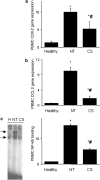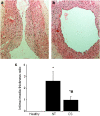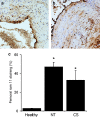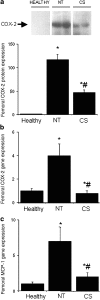Effect of chondroitin sulphate in a rabbit model of atherosclerosis aggravated by chronic arthritis
- PMID: 18536737
- PMCID: PMC2439856
- DOI: 10.1038/bjp.2008.113
Effect of chondroitin sulphate in a rabbit model of atherosclerosis aggravated by chronic arthritis
Abstract
Background and purpose: Among the agents employed to manage osteoarthritis, chondroitin sulphate (CS) is a natural glycosaminoglycan with an anti-inflammatory effect on joint cells. CS might also influence the inflammatory component of atherosclerosis. Our aim was to examine the effect of CS administration on vascular injury and on markers of systemic inflammation in a rabbit model of atherosclerosis aggravated by systemic inflammation provoked by chronic antigen-induced arthritis.
Experimental approach: Atherosclerosis was induced in rabbits by maintaining them on a hyperlipidaemic diet after producing an endothelial lesion in the femoral arteries. Simultaneously, chronic arthritis was induced in these animals by repeated intraarticular injections of ovalbumin in previously immunized rabbits. A group of these rabbits were treated prophylactically with CS (100 mg kg(-1)day(-1)) and when the animals were killed, serum and peripheral blood mononuclear cells (PBMC) were isolated. Furthermore, femoral arteries and thoracic aorta were used for gene expression studies and histological examination.
Key results: CS administration reduced the concentration of the proinflammatory molecules C-reactive protein and IL-6 in serum. Likewise, CS inhibited the expression of CCL2/monocyte chemoattractant protein (MCP)-1 and cyclooxygenase (COX)-2 in PBMC, and reduced the nuclear translocation of nuclear factor-kappaB. In the femoral lesion, CS also diminished the expression of CCL2 and COX-2, as well as the ratio of the intima/media thickness. Moreover, CS decreased the percentage of rabbits with atherosclerosis and chronic arthritis that developed vascular lesions in the aorta.
Conclusions and implications: These findings suggest that CS treatment may to some extent impede the progression of atherosclerosis.
Figures







Similar articles
-
Anti-inflammatory activity of chondroitin sulphate: new functions from an old natural macromolecule.Inflammopharmacology. 2011 Dec;19(6):299-306. doi: 10.1007/s10787-011-0098-0. Epub 2011 Nov 1. Inflammopharmacology. 2011. PMID: 22042237 Review.
-
Effect of a high dose of glucosamine on systemic and tissue inflammation in an experimental model of atherosclerosis aggravated by chronic arthritis.Am J Physiol Heart Circ Physiol. 2009 Jul;297(1):H268-76. doi: 10.1152/ajpheart.00142.2009. Epub 2009 May 1. Am J Physiol Heart Circ Physiol. 2009. PMID: 19411287
-
Chondroitin sulfate improves synovitis in rabbits with chronic antigen-induced arthritis.Osteoarthritis Cartilage. 2010 Jun;18 Suppl 1:S17-23. doi: 10.1016/j.joca.2010.01.017. Epub 2010 Apr 28. Osteoarthritis Cartilage. 2010. PMID: 20399901
-
Chronic arthritis aggravates vascular lesions in rabbits with atherosclerosis: a novel model of atherosclerosis associated with chronic inflammation.Arthritis Rheum. 2008 Sep;58(9):2723-34. doi: 10.1002/art.23765. Arthritis Rheum. 2008. PMID: 18759289
-
Improvement of experimental accelerated atherosclerosis by chondroitin sulphate.Osteoarthritis Cartilage. 2010 Jun;18 Suppl 1:S12-6. doi: 10.1016/j.joca.2010.01.014. Epub 2010 Apr 24. Osteoarthritis Cartilage. 2010. PMID: 20399896 Review.
Cited by
-
The 'sweet' and 'bitter' involvement of glycosaminoglycans in lung diseases: pharmacotherapeutic relevance.Br J Pharmacol. 2009 Aug;157(7):1111-27. doi: 10.1111/j.1476-5381.2009.00279.x. Epub 2009 Jun 5. Br J Pharmacol. 2009. PMID: 19508395 Free PMC article. Review.
-
Anti-inflammatory activity of chondroitin sulphate: new functions from an old natural macromolecule.Inflammopharmacology. 2011 Dec;19(6):299-306. doi: 10.1007/s10787-011-0098-0. Epub 2011 Nov 1. Inflammopharmacology. 2011. PMID: 22042237 Review.
-
Risk of acute myocardial infarction among new users of chondroitin sulfate: A nested case-control study.PLoS One. 2021 Jul 12;16(7):e0253932. doi: 10.1371/journal.pone.0253932. eCollection 2021. PLoS One. 2021. PMID: 34252115 Free PMC article.
-
Total mortality risk in relation to use of less-common dietary supplements.Am J Clin Nutr. 2010 Jun;91(6):1791-800. doi: 10.3945/ajcn.2009.28639. Epub 2010 Apr 21. Am J Clin Nutr. 2010. PMID: 20410091 Free PMC article.
-
CXCL9, IL2RB, and SPP1, potential diagnostic biomarkers in the co-morbidity pattern of atherosclerosis and non-alcoholic steatohepatitis.Sci Rep. 2024 Jul 16;14(1):16364. doi: 10.1038/s41598-024-66287-4. Sci Rep. 2024. PMID: 39013959 Free PMC article.
References
-
- Álvarez-Soria MA, Largo R, Santillana J, Sánchez-Pernaute O, Calvo E, Hernández M, et al. Long term NSAID treatment inhibits COX-2 synthesis in the knee synovial membrane of patients with osteoarthritis: differential proinflammatory cytokine profile between celecoxib and aceclofenac. Ann Rheum Dis. 2006;65:998–1005. - PMC - PubMed
-
- Álvarez-Soria MA, Largo R, Santillana J, Calvo E, Egido J, Herrero-Beaumont G. Differential anticatabolic profile of glucosamine sulfate versus other anti-osteoarthritic drugs on human osteoarthritic chondrocytes and synovial fibroblast in culture. Osteoarthritis Cartilage. 2005;13:S153.
-
- Bali JP, Cousse H, Neuzil E. Biochemical basis of the pharmacologic action of chondroitin sulfates on the osteoarticular system. Semin Arthritis Rheum. 2001;31:58–68. - PubMed
-
- Barnes PJ, Karin M. Nuclear factor-kappaB: a pivotal transcription factor in chronic inflammatory diseases. N Engl J Med. 1997;336:1066–1071. - PubMed
-
- Benito MJ, Sánchez-Pernaute O, López-Armada MJ, Hernández P, Palacios I, Egido J, et al. Cyclosporin A prevents the histologic damage of antigen arthritis without inducing fibrosis. Arthritis Rheum. 2000;43:311–319. - PubMed
Publication types
MeSH terms
Substances
LinkOut - more resources
Full Text Sources
Other Literature Sources
Medical
Research Materials
Miscellaneous

